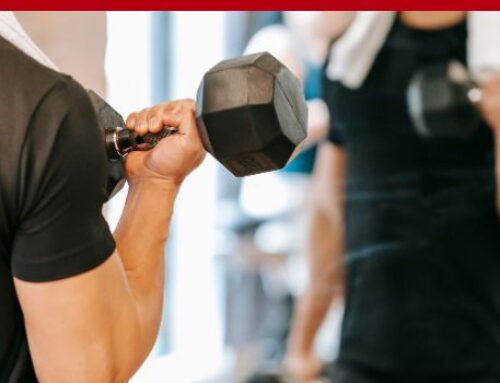
Ted Talk 158: “I Hurt Myself Working Out. What Should I Do?” – Ask Ted
Getting muscle soreness after working out is expected at a certain point, especially if you are pushing yourself to build muscle. Building muscle is an uncomfortable process; muscle fibers must tear to grow.
Feeling pain in a particular muscle while performing an exercise is entirely different. The pain you feel during a specific movement is a sign the muscle sends to the brain, indicating some inflammation or problem.
So, should we keep going or stop working out when the joint or muscle pain is bearable? And what about the other areas of our body? Should we stop working on them too?
This is the question Ted answers in today’s Ask Ted episode.
He reveals the best thing to do when feeling pain while working out. He talks about his experience, how he handled this issue in his 20s, and the things he would do knowing what he knows today.
Ted also shares his best strategies if you get hurt, what you should avoid at all costs, and much more. Listen now!
You’ll learn:
- Why sometimes is better to tap than to win the battle
- The consequences of ignoring the messages the body sends
- What is the pain really telling you, and why should you pay more attention to it
- How can a professional help you avoid repeating the same mistakes
- How does lifestyle affect your recovery
- What are the supplements that help speed healing after an injury?
- And much more…
Related Episodes:
253: How To Stay Lean, Strong And Pain-Free After 40 with Dr. John Rusin
431: How To Stay Active, Stronger And Injure Free As You Age With Dr. Chad Waterbury
212: 6 Ways To Prevent Weight Training Injuries And Improve Flexibility
Do You Need Help Creating A Lean Energetic Body And Still Enjoy Life?
We help successful entrepreneurs, executives, and other high-performers burn fat, transform their bodies, and grow successful businesses while enjoying their social life, vacations, and lifestyle.
If you’re ready to have the body you deserve, look and feel younger, and say goodbye to time-consuming workouts and crazy diets, we can help you.
Click Here To Schedule Your 15-Min Strategy Call!
Or go to legendarylifeprogram.com/free to watch my FREE Body Breakthrough Masterclass.
Podcast Transcription: "I Hurt Myself Working Out. What Should I Do?" - Ask Ted
Ted Ryce: How do you know when to stop your workout, when you’re feeling a mild injury versus getting in the work when the pain is tolerable, finishing a workout when the pain is tolerable. That is the question we’re going to answer today on this episode of Ask Ted?
So, what is up, my friend? Welcome back to the Legendary Life Podcast. I’m your host, Ted Ryce, coach to entrepreneurs, executives, and other high-performing professionals.
So, let’s dive right into the question. And this comes from ACOM Fantasy. It’s The handle name on Twitter. “I have a mild sprain on my right glute after doing sumo. So, I don’t know if it’s a sumo squat or a sumo deadlift, but after doing sumo. I assume it’s not sumo wrestling.”
It could be. It could strain your glute like that for sure. Sorry. “I was still able to get through the rest of the workout despite feeling it. How do you know when to shut it down versus getting in work with when the pain is tolerable?”
So, I don’t know about you, but we all get faced with this: If we’re in the gym pushing, we’re going to be faced with a mild entry and we’re going to have to ask ourselves, “Okay. Should I stop or should I push through?”
And what I want to tell you is: I’ve had a habit of pushing through in the past, and now I don’t do That. I’ll tell you one thing that happened to me. As many of you know, I did Brazilian Jiu-jitsu. I’ve been doing it for a long time. I’m on a bit of a break at the moment but I have my brown belt. I spent many years Practicing Brazilian Jiu-jitsu. I taught Brazilian Jiu-jitsu for years. The basic Brazilian Jiu-jitsu for years and I also competed.
Now, I was never a world champion, but I was a state champion and I won more tournaments than I’ve lost, won more matches than I’ve lost, and probably competed maybe 20 rounds, 20-ish times.
And I remember one day when I was a purple belt, that’s when I was quite serious and I was in class rolling, which is the world Brazilian Jiu-jitsu practitioners used for sparring. I was sparring with a blue belt and the guy was pretty good. I was way better of course, but he caught me with something called a knee bar, which is a joint lock directed at your knee and the goal is to hyperextend the knee to get someone to tap out or you hyperextend their knee. That’s what Brazilian Jiu-jitsu is about, folks. That is choking people so much fun anyway.
So, this guy got me and what’s worse is knee bar, that’s one of my go-to moves. It was my freaking move and this guy got me with my move. Can you hear the ego talking already? And so, he got me with my move.
And here’s the thing: I was good at, not just doing knee bars but getting out of them. And he got me good, but I knew I could get out of it. I was like, “This guy isn’t good enough to tap me.” And so, what happened?
Well, I escaped and I didn’t tap and I beat him except I’m the one who lost because although I didn’t tap and I won that match, I didn’t even get a medal for it. It was just training in the gym, it was just a workout, in other words, I would go on to have problems with that knee for like, I had problems with it today.
When this happened, I was 28/29, so over 15 years ago/16 years ago, right? And not only did I not tap and suffer some injury to my knee, it might have been okay, but what I did next was especially not smart. So, I got back into the gym and I went back to my workouts. I don’t know, I took a couple of days off, but I went back to my workouts.
And in my defense, I didn’t know what to do. I didn’t have any experts telling me…There was no Legendary Life Podcast at the time, or YouTube videos telling you, “Oh, hey, this is what, you don’t Google how to fix your knee injury and have like a billion YouTube videos come up or a bunch of podcasts.”
There wasn’t the level of information available now. Even though a lot of the information now isn’t that great, but still at least it can give you a path to follow. And I just didn’t know any better.
So, what I did was I jumped back into my workout and I remember, I still remember this, I was doing lunges and I was using 60 or 70-pound dumbbells with the lunges because that’s what I had worked up to.
And of course, like I felt like, “Well I hurt my knee, but it seems to be better. And certainly, I want to keep getting stronger in my workout. So, I’m just going to jump back into my leg workout and lift the same amount of weight, right? Because I don’t want to get weaker, right?”
Except, I remember feeling my knee, and it wasn’t terrible, I didn’t have to drop weights and fall in pain or anything like that. But I felt my knee and I was like, ‘Man, that was not smart.”
And again, I feel my knees today. Now they’re quite good these days, but I have to be very careful because they can easily feel bad if I overdo it. The tissue tolerance of my knees is not that strong anymore. I don’t do impact exercises, I don’t do jumping exercises. I have to be careful because it’ll just hurt my knee.
And I have to be careful on lifting weights and a bunch of other things all because I didn’t tap to that knee bar and I went back to exercising and training it right away with the same exercises and with the same weight and I worked through the pain.
Now that I’ve shared that story and you know of my idiocy of my twenties, now I want to tell you what I think I would do in that situation if I was in it again or in this situation, if I strained or sprained my glutes.
So, the first thing I’d say is this, I’m not a doctor, but I’m going to try to help you. And here’s what I do now. I stop my workout if I feel pain and I stop it right away. I don’t finish this set because now I know.
So, this is number one, you stop your workout or at least stop the exercise. You don’t have to stop your workout if it’s like, “Well, I hurt my glute, but I’m going to do some shoulder exercises.” You can keep going with your shoulder. You don’t have to…
In fact, that’s a really good lesson I used to do that too and now and eventually I learned, “Okay, well I can still work my upper body, I can still work around my knee, I could still work in this case around the hip injury.” There’s nothing wrong with doing that.
In fact, that’s a great thing to do because the last thing you want to do is to stop exercising completely. So, number one is to stop whenever you feel a strain sprain or whatever. You stop doing that exercise and you avoid any exercises that cause pain because what is the pain? It’s a message to your brain from that area saying there’s some inflammation, there’s a problem.
And if you’re experiencing more pain or continued pain, that means that you’re continuing to cause inflammation. So, stop! Never work through it if your goal is long-term health. If it’s just to get in shape and of course, this is a rhetorical thing to say, if it’s just to get in shape for 12 weeks to look good for next summer, then destroy your body, right?
But that’s not… I think 99.9% of people, what they want is they want to get in great shape and stay in great shape and injuries make it harder to do that. Oh, man, the strategies I have to use now, the complicated warmups and exercises that I’ve had to learn over the years, ugh, don’t do that to yourself because you will have to hire someone like me.
Because even physical therapists, a lot of physical therapists aren’t that great. They can get you out of acute pain. But then if you’re talking about what you do for the long term, what works for that, you’re going to have to find someone like me. So, stop when you feel it.
Number two is to see a professional. Notice that the person said, “I have a mild sprain on my right glute.” So, the glute is a muscle and a sprain is an injury to a ligament. So, right then and there, there’s a glaring lack of knowledge. That’s okay because you’re not supposed to be a doctor.
And even doctors don’t know about... Even doctors like Liver Specialists may not know all the differences here when it comes to orthopedic injuries, it’s okay. But see a professional, see a doctor or a physical therapist because a sprain is an injury to a ligament caused by the tearing of the fibers of that ligament.
But a sprain is an injury to a muscle or tendon so sprain and strain. And it’s important to know the difference because if you do have ligaments in your hip on the head of your… not your humerus, your femur. You have ligaments in there, but you also have muscles and tendons.
And the tendons attach muscle to bone, ligaments attach bone to bone, okay? Don’t need to memorize this, but if this is making your eyes glaze over, time to see a medical doctor about it or a physical therapist because it kind of... I don’t know what the laws are now.
Personally, I tend to go to a physical therapist unless I need it. And the last physical therapist that I saw referred me to a solid orthopedic surgeon to get some imaging done. So, a good physical therapist or good orthopedic doctor will have someone to refer you to either way, because imaging and so diagnosis… And diagnosis using imaging is really important but also where do you go from there now that you have an idea of what the problem is?
So, stop your workout, and see a professional. Number three is focused on recovery. Follow the physical therapist’s plan for treatment. Make sure that you re-examine your workout and motivation for working out. Learn the lesson so you don’t repeat this.
And of course, stay away from exercises or workouts that cause pain or inflammation to increase in that area, all right? So, now we have: stop your workout, see a professional, focus on recovery, and then we have a focus on lifestyle to speed up healing.
So, one thing that’s important that I learned much later on, unfortunately, is I thought that injuries just healed on their own and it didn’t matter what you did so much for.
As an example, in my 20s actually, in those days I wasn’t going out so much, but I was smoking a lot of weed. I did drink alcohol quite a bit. I didn’t sleep well. But those things affect healing. So, here’s what I would tell you now.
Make sure you’re sleeping at least seven hours per night. Lose excess fat. Fat? Excess fat, in particular, visceral fat in particular is not just stored energy in your body for the famine that’ll never come. It also is metabolic.
In other words, it releases inflammatory chemicals that increase the level of inflammation in your body. So, losing excess fat will help you heal. This is my experience, but there are also some data, not specifically like, “Oh, well, losing fat help with healing a ligament sprain or muscle strain.” So, I don’t know if there’s any research like that.
Maybe not, but I don’t even care, to be honest. It’s like, we know that this is important, right? And it’s something you should do anyway to lose excess fat. And then the fifth thing would be to take supplements that help with inflammation and recovery, for example. Take omega-3 fatty acids.
We used to think back in the day that having Omega-3 to Omega-6 ratio, we thought the ratio was really important. And now what we know is this: It’s not so much about the Omega-6 fatty acids, how much of them you eat, how much of them you don’t, irrespective of the calories. I mean, the calories matter, but what matters is getting enough Omega-3 fatty acids.
So, the American Heart Association recommends that adults take between 500 to 1,000 milligrams of Omega-3’s per day. I would also add in, take 20 grams of collagen peptides. I take 20 grams of collagen peptides every single day. I take it before my workouts, I take it every day on the days I workout.
I try to take it about an hour before a workout, because there’s some research showing that if you take the collagen right before you do an activity that targets an area that is injured, like cartilage, bone, ligament, tendon, the collagen can help. It can help get collagen into that area. That research comes from Keith Barr, a brilliant scientist and someone I want to get back on the podcast.
And the last thing I put is to take five grams of Creatine per day. Creatine is just –it helps with sleep loss, it helps with cognition. I believe it helps with injury recovery. I think there may even be some research on it not sure because it’s just one of those things, it’s just so obvious. It’s not always nice to have research, but I’ll need research to inform every single decision I make.
So, Creatine has enough research on it to show that you should be taking it anyway. I personally feel it helps me recover from injuries faster. So, just to recap here, number one is to stop your workout whenever you feel some type of injury if long-term health is your goal.
Number two, seek an orthopedic physician or physical therapist for an evaluation. And I would even add in: if it’s something that’s kind of chronically bothering you after you’ve been treated by a physical therapist, then find someone like me who can help you, or a physical therapist that also has a strength and conditioning background, that’s important.
Because what physical therapists, just a quick tangent, but what physical therapists usually fail to do is they’ll get you out of pain, but then it’s like, “Well, okay, I’m out of pain but then I tried to go do the thing. I tried to do a sumo deadlift again and it hurt.”
So, they can get you out of pain, but they can’t get you back to where you want to be building that tissue tolerance so that you can go back to what you want to do so you’ll need an expert that can help you do that. That’s me, by the way, folks. But it’s also other people can help as well. It’s not just me.
And so, the third thing is to focus on your lifestyle to speed up healing. So, sleeping seven hours per night, losing excess fat. And the last one is taking supplements that help with recovery.
So, taking at least 500 to 1,000 milligrams of Omega fatty acids every day, that’s what the American Heart Association recommends for adults, taking 20 grams of Collagen Peptides. I use Vital Proteins, Collagen Peptides, and take five grams of Creatine every day.
And just as long as it says German micronize Creatine or Creapure on the label, it doesn’t matter what brand of Creatine you take, it’s all the same stuff. Just look for German micronized Creatine or Creapure, the brand name Creapure.
So, you might buy someone’s, let’s say “Get Huge” brand supplements, but if you read about what’s in the Get Huge supplement, Creatine monohydrate supplement, you’ll see it says Creapure on it or it says German micronized Creatine on it. That’s what you want to get.
And that’s what I would say, folks, but definitely don’t make the mistakes that I did because what starts as a minor entry can turn into a chronic entry that, for example, I don’t do deadlifts and squats anymore because of the injuries that I don’t do them in the same way that you might do them because I’ve had to adjust things, adjust my workouts to make sure I don’t cause further damage. And let me tell you: it gets quite technical and it’s annoying, okay? It’s annoying.
And the alternative though is for me to… I actually hurt worse when I don’t exercise. So, I start to feel the injuries start to ache again, which is normal, right? The weaker your muscles are, the more your joints will have to take the brunt of the movement that you do every day, whether that’s just walking up steps or doing Brazilian Jiu-jitsu or doing sumo deadlifts in the gym.
So don’t get to that point, folks. Learn from my mistake here and definitely focus. Always play the long game and do what’s good for you long term. If you have the plan, the goal, rather, to be 65, 75, maybe even 85, still doing the things that you love to do in your life. So that’s it for me. Hope this helps and have a great weekend. Speak to you on Monday.
Sign up to receive email updates
Enter your name and email address below and I'll send you periodic updates about the podcast.
Similar Episodes you may like
About the Show
The Legendary Life is a fun and enlightening look at health fitness, nutrition, biohacking, fat loss, anti-aging, and cutting-edge health advice from celebrity fitness trainer Ted Ryce. Ted’s clientele consists of celebrities, including Richard Branson, Ricky Martin, and Robert Downey Jr., CEOs of multimillion-dollar companies, and other high performers.
He breaks down countless health topics and provides science-backed solutions and the most effective, uncommon strategies to rapidly lose weight, improve your health, and upgrade your physical and mental performance, so you can live the life you deserve.
He breaks it down by providing science-based information so you can clear up the confusion and finally lose weight, fight disease, and live a longer, healthier life.
No guru. No fluff. And no preaching of generic fitness advice here. Along the way, Ted shares his own journey of how he turned great tragedy and loss into success and hope.
Now, his mission is to empower you with the tools and the knowledge you need to live your best life. New episodes every Monday and Friday.





